Video reports of our 1250 km, bone-rattling journey in Ladakh.
http://www.ndtv.com/article/india/ground-report-from-ladakh-s-neglected-border-areas-576629
All the above reports were based on this journey chronicled below.
Day I, 28 July: We leave Leh, Ladakh’s capital exactly at 7. In fact when you travel in the mountains, its always best to start as early as possible, even may be an hour before we actually left. Our first destination: Phobrang village (see map). As we follow the District Collector Simrandeep Singh’s vehicle, we pass through the usual tourist sites–Sindhu Darshan, Shey–before climbing on to the Chang La, one of the highest passes in Ladakh at 17688 feet. A throng of tourists are busy clicking pictures. After all, this is the peak tourist season in the area. A quick glass of warm water and we are on our way to Darbuk.
Ten km down the road, a group of villagers
 |
| The original map by Aarti and Harsh |
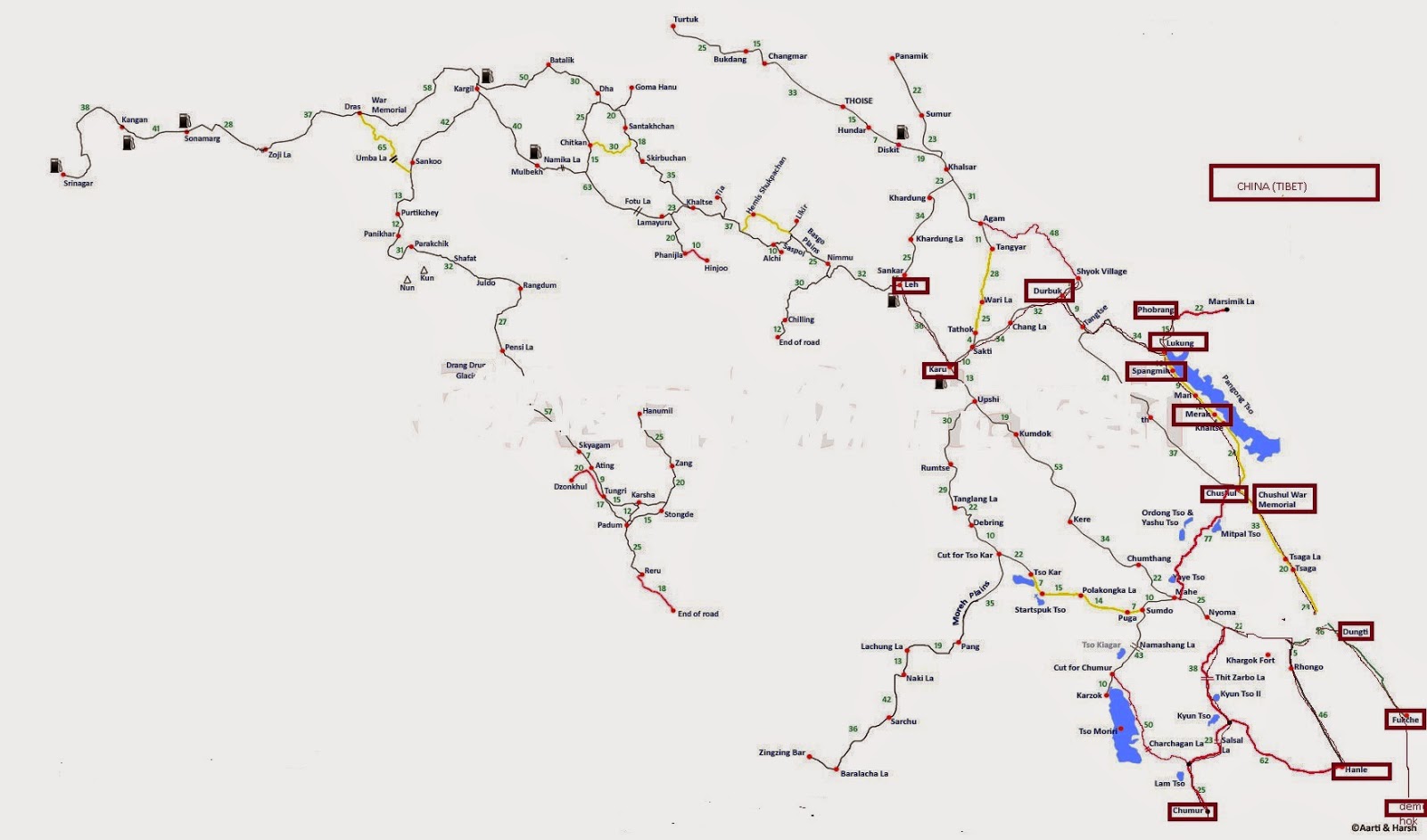 |
| Our journey, marked by maroon squares
|
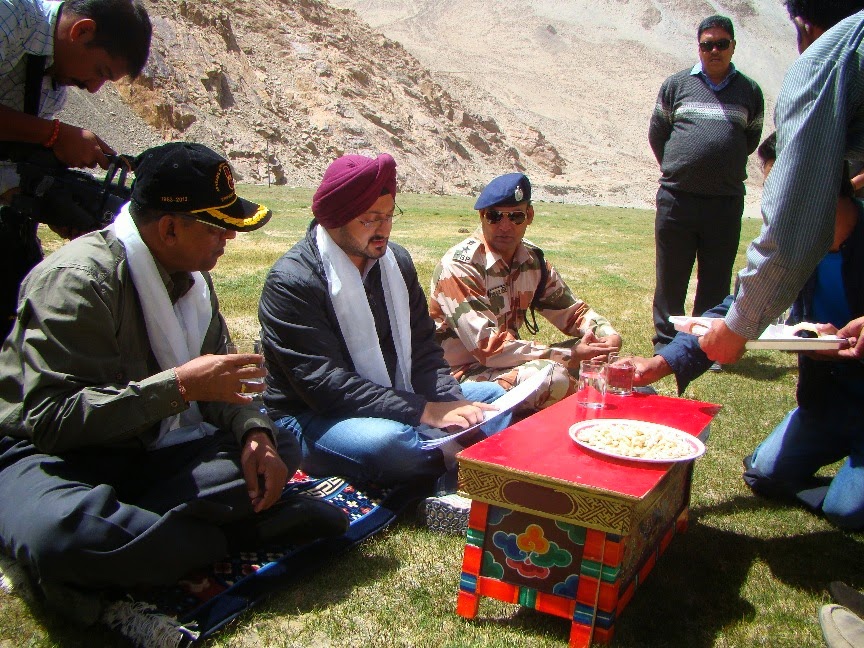 |
| Dist Collector Simrandeep Singh reading a memorandum |
from Shyok, which is slightly off the main road, stop the Collector’s car. The young collector, decides to hold an impromptu roadside meeting. The villagers have come prepared with a flat, low table, carpets to sit on, tea and snacks for the collector’s party. After all, not every day does the collector come visiting. After the traditional welcome, the whole party from Leh squats on the grass as villagers pour out their woes. They have a whole list of demands for their tiny village; an irrigation facility left incomplete, a road in a state of disrepair. Very basic demands but important nevertheless. Simrandeep gives them a patient hearing, asks his assistant for details of projects earmarked for Shyok and assures action on doable points. Quite apart from the instant decision making, it is refreshing to see absence of an intrusive security around the collector. The villagers are speaking to him one to one and without any fear. Its educative to see grassroots administrator in action!
 |
| At Pangang Tso |
 |
| At Chushul |
Twenty minutes later, we are off to Phobrang, first of the border villages along the Line of Actual Control with China. There are 22 to 26 such villages, depending on whether you consider an hamlet with barely four houses as a village or a settlement. Phobrang is co-located with an ITBP (Indo-Tibetan Border Police) camp. The ITBP, as the name suggests is the first line of border defence forces along the LAC. Established in 1963, immediately after the India-China war in 1962, the men of this force remain deployed at high altitude throughout their careers and are veterans of the China border.
 |
| An agitated villager at Merak |
Local ITBP commandants sit with the District Collector for a meeting with the villagers to hear their problems first hand. Phabrong villagers have a big grouse: They are prevented from taking their cattle to the traditional pasture land close to the LAC; the ITBP has a standard reply: Agreements between India and China mandates certain restrictions and therefore they are bound by Govt of India guidelines! A refrain we were to hear throughout the 72-hour, 1250 km journey in Eastern Ladakh earlier this week.
 |
| Simrandeep Singh, the young collector |
The District Collector, perhaps first such officer to visit these remote, inaccessible areas in half a decade, notes everything down in his diary, tells his assistant to take note of special needs and gives decision in some cases on the spot. He has already reversed an old ratio of spending 70 per cent of the BADP (Border Area Development Programme) funds in areas other than border villages. In this year’s budget the border villages will actually get 70 per cent of the allotted money.
A quick, local lunch prepared by the villagers and we are off to Lukung, at the very edge of the beautiful Pangong Tso (lake). A string of villages along the lake starting with Spangmik, Mena, Merak takes us to Chushul late evening. An eventful day ends with a long discussion with an Army Unit which was in Assam and the one I had visited in 2007! A sumptuous dinner later, we crash around midnight tired to the bones. Tomorrow is another day.
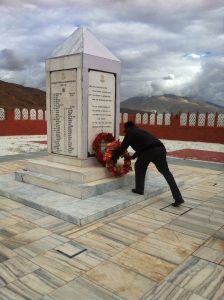 |
| Paying my respects to the gallant 13 Kumaonis |
 |
| In contemplative mood at Rezangla |
 Day II, 29 July: Departure 6.45 am. Breakfast at the ITBP camp in Chushul. Astonished to learn that this post has been located here since 1963. Even now, Chushul is back of the beyond. Even now, this fairly largish village has ONE telephone that is shared between villagers, ITBP and the Army. I am left wondering what would it have been five decades ago! Nothing has changed since my last visit here in 2007 when I had stayed at this location (at 14450 feet) for two days. The road in and out of the village and Army battalion HQ is as dusty as before; electricity is non-existent; there is one weekly bus service to Leh, the district capital! We are headed to Tasga La village (see map) as a first stop. But there is duty to be done: pay our respects at the Rezang La War Memorial built in memory of the 113 brave hearts of the 13 Kumaon Battalion who fought to the last man, last bullet and died in the line of duty in the summer of 1962, facing Chinese human waves. The memory of Maj Shaitan Singh, Param Vir Chakra and his 112 ferocious Ahirs lives on at this desolate spot. Tears automatically well up as I lay a wreath at this starkly simple monument, barely a dot in the vast Ladakh flat land.
Day II, 29 July: Departure 6.45 am. Breakfast at the ITBP camp in Chushul. Astonished to learn that this post has been located here since 1963. Even now, Chushul is back of the beyond. Even now, this fairly largish village has ONE telephone that is shared between villagers, ITBP and the Army. I am left wondering what would it have been five decades ago! Nothing has changed since my last visit here in 2007 when I had stayed at this location (at 14450 feet) for two days. The road in and out of the village and Army battalion HQ is as dusty as before; electricity is non-existent; there is one weekly bus service to Leh, the district capital! We are headed to Tasga La village (see map) as a first stop. But there is duty to be done: pay our respects at the Rezang La War Memorial built in memory of the 113 brave hearts of the 13 Kumaon Battalion who fought to the last man, last bullet and died in the line of duty in the summer of 1962, facing Chinese human waves. The memory of Maj Shaitan Singh, Param Vir Chakra and his 112 ferocious Ahirs lives on at this desolate spot. Tears automatically well up as I lay a wreath at this starkly simple monument, barely a dot in the vast Ladakh flat land.
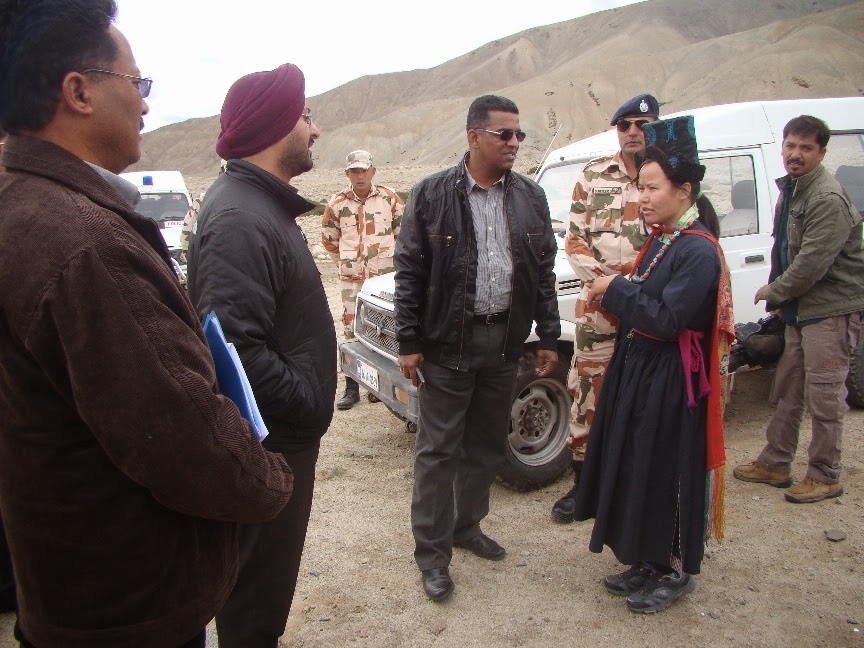 |
| Speaking to Rinchin |
At Tsaga La village, as the Collector sits down with the villagers, I am pleasantly surprised to run into a young Rinchin, prettily dressed in traditional Ladakhi dress. A post-graduate in Political Science from IGNOU, Rinchin has come back home to spread awareness and with a zeal to educate the village children. “Life has no meaning without education,” she explains. “Other facilities will come with time, but the urgent need is to impart education,” young Rinchin tells me.
 |
| A Tibetan nomad |
The Collector meanwhile has heard the familiar demands: a pucca road, at least one telephone connection in the village and electricity. He points out that solar energy is the focus of the government and all households should get their rightful due in some years. But agrees that roads must be built on priority.We move on. Now its going to be a minimum of five hours of drive to Demchock, at the southern most extreme point in Eastern Ladakh where frequent stand offs between Indian Army and PLA troops is common. On the way, we run into nomads who stop us and complain about shriking pastures and the tendency among Indian security forces to restrain Indian Ribos (nomads) from venturing close to the LAC. The District Collector turns to the accompanying ITBP officials and seeks to understand the ITBP argument in keeping the nomads away. Simrandeep is not satisfied. But we carry on nevertheless. As we hit the final stretch to Demchock, the ground is flat and naturally gravelled but there is no road. Army battle tanks can roll on this terrain very easily, I think to myself but even a Mahindra SUV has its limits. Two hours of bumpy ride along the Indus brings us to Demchock, the absolutely last village on the Indian side.
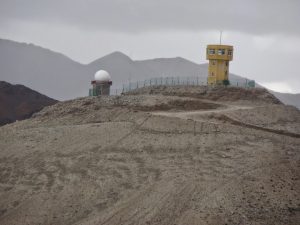 |
| The Chinese post across Demchok |
It starts raining. The lone policeman, accompanying Simrandeep tells me “rain means good omen.” We arrive at Demchock. Only the Demchock nallah, now overflowing because of rains, divides India and China. At a distance I can see multi-storey buildings, a watch tower and a giant ball (perhaps a radar, a snooping device) on the Chinese side. The villagers are agitated. They have been prevented, they claim from going to what is rightfully Indian territory. Local army and ITBP officials remain silent. They want to brief the Collector separately on the complex issues involved in the delicate boundary situation.
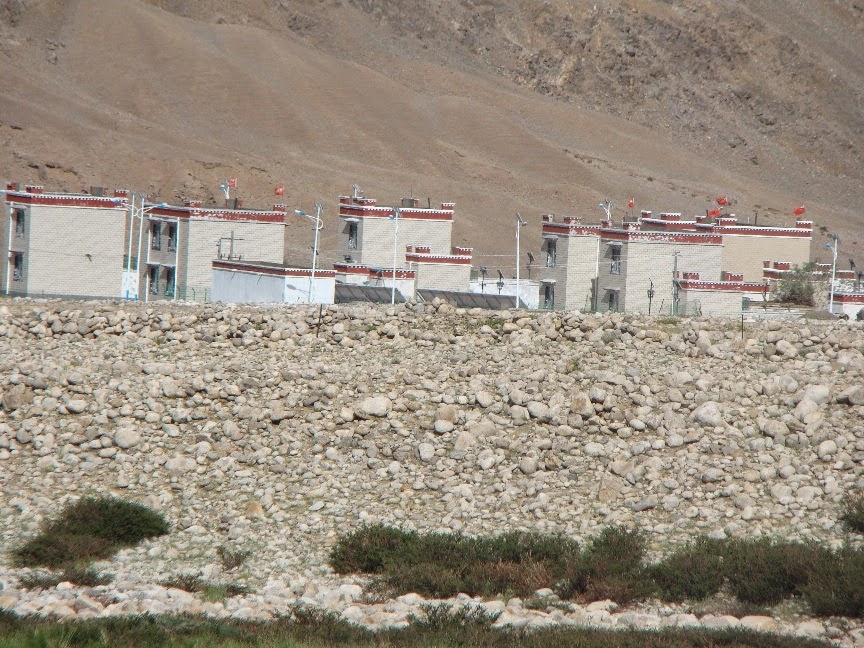 |
| A double story colony for Chinese Ribos across Demchok |
The Collector decides to go a little further and inspect the spot for himself but a sudden surge of water in the nallah prevents us from going to what is called the T-point. At the zero point on the LAC, my so-far dead phone springs to life! Text messages start coming in fast and furious! I am amazed but a closer look reveals that the signal on my phone is from a Chinese Cell phone provider! The Chinese have managed to get their mobile network right up to the LAC. On the Indian side, even a landline is rare! That tells me all that is there to know about the state of infrastructure on the Indian side!
Its getting late. We have another five hours to travel back to Hanle. If we had travelled in a straight line, the journey time would have been cut down by half but the road is incomplete, so the circuitous route it is.
A long bumpy ride back, brings us to Hanle, base to the Indian Astronomical Observatory, reputed to be the world’s highest observatory. The guest house is decent but basic. Tired to the bone after a 15 hour road journey, we have a hot meal and hit the bed. But not before realising that tomorrow is going to be longer!
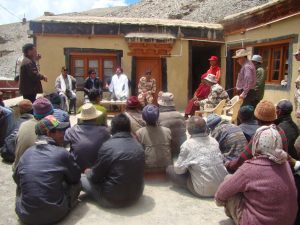 |
| Villagers at Chumur |
Day II, 30 July: Two days of bone crushing travel has sapped the energy but not the spirit, so we set out again around 7.30 am, this time the destination is Chumar in the news more regularly than other hot spots in Ladakh along the LAC. Once again, unusual rains have cut off the shorter route. So it is not before noon that we reach the banks of the other well known lake in Ladakh–Tso Moriri. But our destination is still at least an hour away. Chumur, on the tri-junction of Ladakh, Himachal Pradesh and China has been the bone of contention between India and China for the last couple of years. In fact, the April 2013, 21-day incursion by PLA troops about 300 km up north in the Depsang plains of Dault Beg Oldie is said to have been done to relieve Indian pressure on weaker Chinese positions in Chumur! Here the local councilor (equivalent of a minister) of the Ladakh Autonomous Hill Development Council is present at the public meeting. And he is one angry public representative! He let’s loose a litany of grievances against the government, and especially against the forces–ITBP and Army for preventing his constituents from using the traditional pastures for their cattle. ” We have been going to Chepzi (an area that is been with the Chinese at least since the 1970s) but now we are stopped well within our own territory. Our pastures have shrunk. We are facing a livelihood crises,” he alleges. The Collector listens to him with patience and promises to check the exact position with Army and ITBP but the assembled people will have none of it. They repeatedly request the Collector to go with them to the area, not very far from where the meeting is taking place. He agrees.
 |
| At Chumur |
So our convoy heads to what looks like a disputed spot. The local ITBP commander gets the jitters. He has been told not to allow anyone beyond a certain point. But preventing local residents is one thing and stopping the District Collector is quite another. So he leads the convoy. After a 15 minute drive on a kutcha road, we are at a point called Mane up to which the PLA troops apparently come almost every second day. “They had come yesterday (29th July),” one of the local residents tells me as I do my piece-to-camera at the troubled spot.
My colleague, cameraperson Manu Nair points out that we must be the first Indian media persons to have reached the place which is in news for almost every month for the past two years for stand offs between Indian and Chinese troops!
After a 15-minute inspection of the spot and the terrain around the area, we head back to the ITBP camp. A quick lunch accompanied by an explanation of the situation on the detailed map later, we are on the road again.
A seven hour return journey lies ahead. Its not until 11 pm, that we are back at Leh, only to wake up again at 5 to catch the 7 am flight back to Delhi the next day!
A gruelling, 1250 km extremely educative trip is over. The back is beginning to hurt, the knees are creaking but the satisfaction of having seen the situation on ground and understood the pathetic condition of border villages in Ladakh far outweighs the pain!

August 22, 2014 -
leh and laddak has long been neglected by the state and central govt. its high time both the govt give what is due to the docile and honest people of this region.